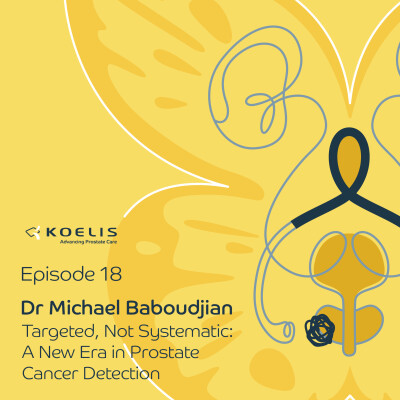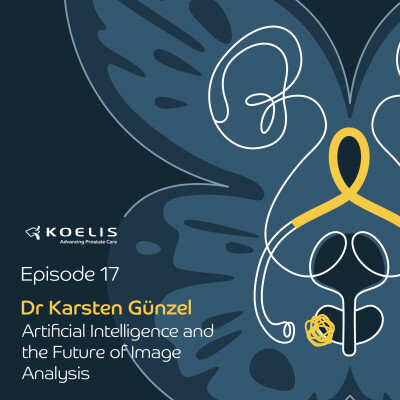- Speaker #0
This podcast is created by Coelis.
- Speaker #1
It takes time to change the practice. We are now living the evolution and it will probably take years to totally abandon transrectal.
- Speaker #0
Prostate Talk. Welcome to Prostate Talk, where we delve into the lightest advancements and breakthroughs in the field of urology. I'm your host, Thomas. and I'm delighted to be here with you today. I couldn't resist bringing a touch of French flair to this first episode, and what better way to do it than with a guest who expertises as impressive as his ability to pronounce prostate with an impeccable French accent. In this episode, we are privileged to have Dr. Honracht, a renowned French expert in the field, joining us to shed light on the nuances of this evolving trend. Dr. Honracht will provide insight into the advantages, challenges, and implications of the Transparent Rinal approach, offering a comprehensive understanding of its impact on both patients and urologists alike. Without further ado, let's give a warm virtual welcome to Dr. Julien Rac. Get ready for a conversation that promises to be both educational and, dare I say, a tad more charming than your average podcast. Merci beaucoup for joining us and let's make this episode magnificent. Hi, Dr. Anurag. We are really pleased to welcome you for the first episode of this podcast. How are you?
- Speaker #1
Hello, Thomas. Thank you very much for that kind introduction. I'm fine and I'm really happy to be here.
- Speaker #0
Today, we'll talk about transperineal prostate biopsy. But before to start, could you please introduce yourself to our listeners?
- Speaker #1
Yes, my name is Julien Ract. I live in Paris. I'm a urologist in Hôpital Cochin. I work there since four years now. Before that, I did my med school in Descartes Université, also in Paris, and I was a resident in Paris. Everything in Paris. So I started to work on the biopsy during my medical degree. I also work in a research unit in Hôpital Necker Enfants Malades. we study basic sciences in the field of prostatic disease in general.
- Speaker #0
Thank you so much for this presentation. So just to be curious, why did you choose urology during your medical studies?
- Speaker #1
It's a good question because actually, you know, at the beginning I wanted to do general surgery in order to be a liver transplantation surgeon. But doing my urology residency, it appears to me that the urology includes every aspect of the patient care from the diagnoses, to the follow-up. You know, prostate cancer is a good example, actually, because you take care of the screening, you know, the PSA, the population, the patient questions, the diagnosis, the biopsy. I mean, you do your own biopsy. It's a particularity in neurology. I think it's very important. Then you take care of the therapy, the treatment. It could be the prostatectomy, the surgery, and then you follow your patient. So liver transplantation is an amazing specialty. you do amazing surgery. I admire liver transplantation surgeon but I choose to do a specialty that I consider maybe more complex and more complete.
- Speaker #0
So let's now talk about transperineal prostate biopsy. As you mentioned we know that many physicians are mainly performing transrectal so why are you performing transperineal approach?
- Speaker #1
We started the transperineal in 2019. At the time, everybody was using the transrectal route and people were concerned about infectious complications. So for this infectious complications, several solutions were offered. We offered to do a rectal swab and antibioprophylaxis adapted to this rectal swab. They proposed to do povidone iodine and using the transrectal route and they also proposed to use the transperineal route in order to avoid the rectum and the rectal contamination of the urine. But transperineal was supposed to be painful because, you know, in the 50s, both routes were used, transperineal and transrectal. And for decades, everybody practiced either transperineal or transrectal. And In 2000, people were getting interested in the fusion. So the question was not the route. The question was the fusion. How do we target the lesion? So people forget about the route and they focused about the fusion. And everybody used transrectal because it was more simple, because it was not painful. So after that, in 2019, when people started... to try to do transparent biopsy. They did it under general anesthesia and it implied more time, access to the operating room. You have to remember in 2019, it's COVID time. So we don't have really access to the operating room. So we tried to do in-office procedure under local anesthesia in Hospital Cochin and actually it worked. So several teams at this time published their experiences in the field and they confirmed that transparent is feasible and safe under local anesthesia. In the same time, studies confirmed that there is a very low infectious complication. You know, it's around 1%, which is very, very low because transrectal is between 5% and 7% of infection. And in 2021, the European guidelines, they recommend to use the transparent approach. And careful, it's a strong recommendation. So it's new in the field of prostate diagnoses. So for all these reasons, we perform now only transperineal in Hospital Cochin.
- Speaker #0
And did you talk about it with the other physicians in the Hospital Cochin, for example, about this change to move from transrectal to transperineal approach? Or it's just an opinion that you had in 2019?
- Speaker #1
No, no, we talked with them. Actually, some people disagreed. And we said we have to switch to Transparenol, it's better. And the first reaction was, why should we switch to Transparenol? We do Transrectal, we always did it, it works. So we don't want to change. And then we presented our work, we presented data, scientific data, our data. And with the time, we convinced the people in our department. And it took two years, but everybody switched. And now everybody's convinced. that transperinol is better.
- Speaker #0
Talking about benefits, what are the advantages of transperinol approach?
- Speaker #1
As we just said, the first benefit is the low rate of infections. But if we look closer, we have studies and even meta-analysis that says that povidone iodine and transrectal root can do the same. In fact, it's in the EAU guidelines since 2021. If you use transrectal Despite the guidelines, actually, you have to use povidone iodine. But with povidone iodine, you have almost 1% of infection. So the real benefit regarding infectious complications is that you decrease the infectious rate, but you decrease it without any antibiotics. In 2021, European guidelines recommend transperineal, but they recommend it with antibiotics. Most of the time, it was cefazoline. But in 2023... The European guidelines offers to do Transparenal with no antibiotic at all. This is based on studies using no antibiotic with the same low infectious rate. And that is the real point to use no antibiotic. Because we have to remember, in 2021, fluoroquinolones were banished from the European guidelines, even for Transparenal, because that was the first problem. Using fluoroquinolones for every biopsy, blinded from rectal swab, we increased the fluoroquinolone resistance. In France, the fluoroquinolone resistance, it's almost 15% in 2022. It's huge. So that is the reason why the infectious rates decreased with the transrectal and why we switched to transperineal. Because, you know, you have more resistance, so you have more infection and you continue to use the antibiotics. So that's the problem in the first place. So now we don't put rectal escherichia coli in the urine. Okay. But we don't risk new resistance in 10 years because we don't use any antibiotics. And that's the main point. So except that crucial point, the second aim of the transparent renal is to have a unique approach for biopsy and focal therapy, because we have to realize that focal therapy is rising. And sooner or later, it's going to be a standard of care for selected patients that we still have to precisely define. But still, it's going to be a standard one day. And whatever the energy. Focal therapy will be performed by transperineal route because we have to avoid infection, but we have to avoid rectal injuries. So we have to perform it with the transperineal way. So looking at this picture, biopsy should be done using the same route. And I can go further. It has to be done with the exact same technique, the same device and the same surgeon. It's easier, it's safer and it's reproducible. So there is no question in that. To end this, at the beginning. we thought that transperineal was maybe less precise than the transrectal. And actually, the recent data say that transperineal is even better than transrectal for the detection rate. So for me, there is no question.
- Speaker #0
If there are so many advantages, why urologists are still performing transrectal prostate biopsies?
- Speaker #1
That's a good question. But, you know, it takes time to change the practice. We have to realize that the technique is new. European guidelines changed only two years ago. It's yesterday. The French guidelines will probably change soon, but we are now living the evolution and it will probably take years to totally abandon transrectal. The first barrier is the device. People need to change the device. It takes time. It takes money. You have to negotiate with the hospital. The second barrier is human. The majority of urologists always practice transrectal. It's the same for every change. The first step. is the evidence. You have to do the science, then you do the guidelines, then you have to spread the message. That's actually what we are doing in this podcast. And then you have to teach the technique, facilitating the access to the device, etc., etc. So it takes time.
- Speaker #0
Very interesting. You mentioned the barriers. So according to you, is transperineal approach easier to learn than transrectal approach?
- Speaker #1
I think it's easier, yes. Most of urologists who do transrectal would say no, but I think it's only because they are used to transrectal. As an example, I teach residents the biopsy technique, and I had the occasion to teach both transperineal and transrectal. And I have to say that it's so much faster to teach the transperineal route than the transrectal route. I think the reason is that the sagittal view of the transperineal sonograph offers you an ideal picture of the prostate. You see the base, you see the apex, and you see the whole needle going from the apex to the base. And this is very easy to understand. When you use the transrectal route, you have to move your probe, you have different planes. You have to realize that in the transrectal, the planes are not even parallel. I mean, the human spirit is not designed to analyze planes who are not parallel. So I think it's really, really more difficult. The problem is people know. how to do transrectal, so they think it's easy, but actually transperineal is easier.
- Speaker #0
So I'm sure you already knew my next question, but do you have practical tips and tricks for our listeners to switch from transrectal to transperineal approach?
- Speaker #1
My first advice would be to practice the first cases under general anesthesia. I think it gives you time, serenity, you don't have to deal with the patient, you know the question. The local anesthesia is a technique you have to learn also. For example, in Cochin Hospital, we practice transparineal under local anesthesia or general anesthesia. We ask the patient, do you want to get asleep or do you want to be aware? And patient choose. And I have to say that when the patients are asleep, it's more comfortable. So that's my first advice. My second advice would be to have all the material you need, especially. the stabilization arm. It's really easier. It gets you stability. It gets you your left hand free. I think it's a real help. So you should get it and you should be in the real good condition to try a new technique. And finally, like every surgery, and the urologists are very aware of that, you have to try it with someone who knows how to do it. So if someone teaches you, you're going to be so much faster and so much comfortable. than if you try to do it alone.
- Speaker #0
So earlier you have talked about general anesthesia to start with a transparent approach, but does it mean that we can perform the procedure under local anesthesia?
- Speaker #1
Yes, we can do it under local anesthesia and the technique is the periprostatic nerve block. It is a safe and efficient technique. It allows you to do it in office, which is crucial for a lot of centers because, as we said before, they don't have an easy access to the operating room. So the periprostatic nerve block should be done under ultrasound guidance. After a good skin anesthesia, it's very important because you have to be comfortable for you and the patient with a good skin anesthesia before starting the deep anesthesia. That technique is crucial because you have to remember the problem of transperineal was the pain. So now we know a good technique. It's efficient, it's pain-free, it's safe. So we can say it, transparent renal biopsy are feasible and safe in office under local anesthesia.
- Speaker #0
Does it allow you to reach more patients?
- Speaker #1
Sometimes, I think, because we see patients more and more informed. I think this phenomenon is growing. They have access to internet, they have access to the guidelines. Maybe this podcast, if they listen to it, I don't know, I hope. But they're going to get more and more informed. So they will ask. Please do me transperineal biopsy because I read transperineal is better. So please do me transperineal biopsy. So yeah, I think in the next year, we will see this situation more and more. And I think it's a chance to can offer the good technique to the patient, especially if he knows it.
- Speaker #0
I totally agree. And we definitely see in the previous year that the patients are more informed, are more involved in there. pathology in their disease. And I think it's called the empowerment of patient now. It's a new term to say that the patient wants to take in hand their choices and their journey. So I'm totally agree with you. Anyway, so why is transpirineal prostate biopsy approach isn't the prostate biopsy standard yet?
- Speaker #1
Actually, it's the standard in Europe, according to the European guidelines. In France, it's true. We have our own guidelines, but They will follow this trend very soon, I'm sure. In the United States, it's still different, but we have to remember that in the whole world, everybody is practicing the evidence-based medicine. And actually, we have the evidence. So for me, yes, it's a standard of care.
- Speaker #0
Okay. So before to conclude this amazing interview, if you have to choose two arguments to convince the naysayers, what would they be?
- Speaker #1
First of all, I would reassure them about the fact that it's an easy technique. It's even easier than the one they know. But I understand it. Nobody likes to change. I know how to do transrectal. Why should I do transperineal, you know? But we have to realize that the practice in changing right now with good evidence, so it's inevitable. It's the same thing with every progress, you know? Some people will persist. Remember 15 years ago, there was probably that guy saying like, what? Playing music? taking pictures, go on the internet with just a phone. No way it's going to work. So, you know, when everyone is taking the train, you don't want to be that guy. So you should be the guy who say, yeah, yeah, it's going to work. So I'm going to do transparent right now.
- Speaker #0
Thank you a lot for all this precious information, Dr. Julien Ract. And for your time, we hope that you enjoy it because I enjoy it. I would like to finish this interview with one last question. And you know, it's a funny question if I, if I may say. If you were a song, would it be?
- Speaker #1
If I were a song? Yeah. Happy? Happy. Pharrell Williams.
- Speaker #0
Perfect.
- Speaker #1
Because I was very happy to share this podcast with you. Thank you, Thomas.
- Speaker #0
Thank you, Julien. And thank you for your time. Bye-bye. That's a wrap for today's Prostatalk episode. Huge thanks to our dedicated listeners. If you enjoyed the podcast, make sure to subscribe for more captivating content. Your support. means the world. If you found this informative, quick favor please, drop us a 5-star review. Your feedback helps us grow and deliver credit insights. Have topics you'd love us to cover? Share your ideas in the comments or connect with us on social media. Your input guides future of Pros.Talk. Thanks for being a crucial part of our community. For more urology insights, visit colleagues.com. Stay tuned! And see you next time.






